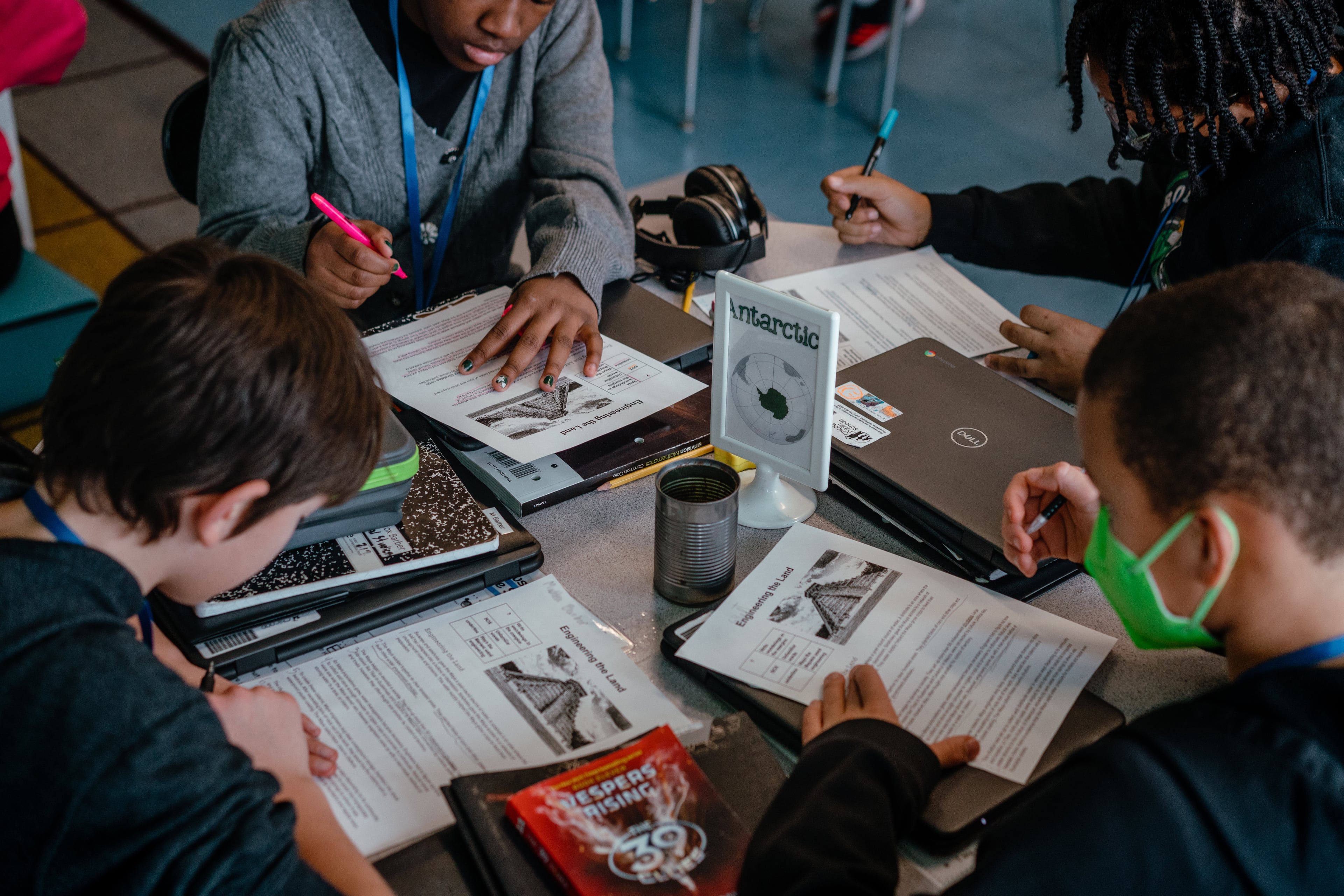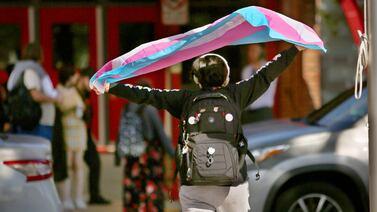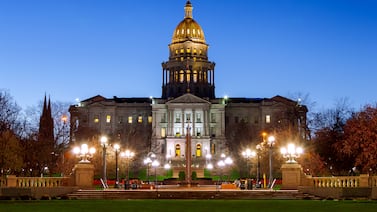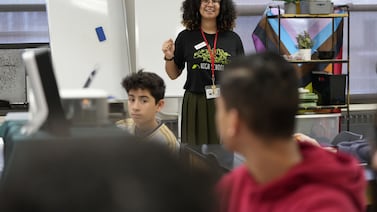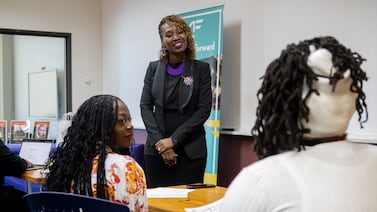Sign up for Chalkbeat Chicago’s free daily newsletter to keep up with the city’s public school system and statewide education policy.
About six years ago, Lori Zaimi’s daughter told her mom that another longtime friend was leaving their elementary school in Edgewater on the North Side. The friend’s apartment building, she explained, had been sold to someone who was going to renovate it.
Zaimi recognized the familiar story of gentrification, when higher-income families move into a working class neighborhood and drive up property values. She’d seen property demolitions and pricey single family housing go up across Edgewater, the formerly working class neighborhood where she grew up.
She has also seen the impact in her daughter’s school, where Zaimi became principal in 2015. These days, she said, rent is “unaffordable for many of our families.”
A decade ago, nearly 73% of students at the school, Helen C. Peirce School of International Studies, came from low-income households, according to district data. Last school year, that figure was just over 34%.
Zaimi’s school is not alone. Ten years ago, 85% of Chicago Public Schools students came from low-income households. Now, that figure is 73% — a 12 percentage point drop — according to district data from the 2022-23 school year. Chicago Public Schools considers a student “economically disadvantaged” if their family’s income is within 185% of the federal poverty line. This year, that threshold is $55,500 or less for a family of four.
The drop, experts say, is driven by several factors, including gentrification, population and enrollment shifts, as well as a potential dissatisfaction with district schools.
Even though the number of students from low-income families has dropped, nearly three-quarters of the district’s student body is still considered “economically disadvantaged.” But if the downward trend continues, Chicago schools could continue to see fewer dollars than expected from the state, which funds districts in part by considering how many students from low-income families are enrolled.
For individual schools, such as Peirce, the decline has led to the loss of Title I money, federal dollars sent to schools with high shares of low-income students. But as the school has become more mixed-income, it has also become more racially diverse: Last school year, Peirce was 47% white and 32% Hispanic, compared to 17% white and 62% Hispanic 10 years ago.
As the district enrolls a smaller share of students from low-income households, Chicago’s schools continue to look different from how they did a decade ago, especially in rapidly changing neighborhoods. That shift raises questions about who schools are serving, how they should be resourced, and what the district — and the city — can do as it continues to lose students.
Low-income drops happening across Chicago, but steeper in some neighborhoods
Peirce is one of more than 200 schools that have seen their share of students from low-income families drop by more than the districtwide decline of 12 percentage points, according to a Chalkbeat analysis of the district’s public school enrollment data from the 2022-23 school year.
The analysis of the past decade also found:
- While overall enrollment has also fallen, it’s still outpaced by the loss of students from low-income families. The district enrolled 31% fewer students from low-income families than in 2013, as the district’s overall enrollment dipped by 20%.
- When looking at neighborhoods, schools in Lincoln Square and Irving Park, on the North Side, and West Elsdon, on the Southwest Side, saw a median 20 percentage point drop or more in students from low-income households since 2013. That’s more than any other community area.
- Nine of the top 10 schools that lost the largest shares of students from low-income households were located on the North Side, across gentrifying neighborhoods.
- Half of them enrolled more children last school year than they did 10 years ago, bucking citywide trends.
- On the opposite end of the spectrum, 73 schools saw increases in their share of students from low-income families. One-third are on the South and West sides — regions that have also lost the most residents between 1999 and 2020, according to a 2022 report from UIC.
CPS officials use two methods to find out which students are from low-income households. They automatically count students who receive certain government aid meant for low-income families, such as Supplemental Nutrition Assistance Program, or SNAP, benefits. And they collect forms handed out at the start of the school year that ask families to report their income, which in the past helped the district determine students who qualified for free or reduced price lunch.
In 2014, CPS became eligible for the federal universal free meals program for districts that serve at least 40% students from low-income families. With less pressure on schools to collect the forms, which are not mandatory, some have suggested that the district may be collecting fewer of them, potentially skewing the data about low-income families.
A CPS spokesperson said it could be “one of several reasons” behind the drop in the district’s share of low-income students. However, district officials declined to share the rate at which forms have been returned over the past decade, instead asking Chalkbeat to file an open records request for that information.
There’s some evidence that those forms do not get filled out, particularly among new students, said Elaine Allensworth, who studies education policy and is Lewis-Sebring Director of the University of Chicago Consortium on School Research.
In the 2014-15 school year, 86% of preschoolers and 81% of kindergartners were listed as coming from low-income families, on par with children in other grades, district data show. The next school year, after the district became federally eligible for universal free lunch, around 62% of preschool and kindergarten students came from low-income families, while figures in older grades shifted just a couple percentage points from the previous year.
“That says to me new families that are coming into CPS are not signing up for free lunch,” Allensworth said, who added that population shifts are also a likely contributing factor.
The current data for early grades could also signal that CPS is likely to see its low-income population decline further. Last school year, nearly one-quarter of preschoolers and close to half of kindergarteners were from low-income families, compared to more than three-quarters of students in nearly all of the older grades.
Multiple principals told Chalkbeat they don’t believe missing paperwork is a big contributor — or that it is a factor at all — since their funding heavily relies on collecting those forms.
Another factor in the drop of low-income students could be a slight uptick in families seeking out private schools. Of Chicago’s low-income families, 10% were enrolled in private school in 2021 — an increase of 3 percentage points from 2019, according to an analysis of Census data by Jose Pacas, chief of data science and research at Kids First Chicago. That’s after little change since 2012, the last time there was a similar increase.
That coincides with the COVID pandemic when CPS switched to virtual learning, as well as the launch of Illinois’ tax credit scholarship program, which began in the 2018-19 school year. The program grants tax credits to people who fund scholarships for low-income students who want to attend private schools. That program is expected to sunset this year.
Some low-income parents, like Blaire Flowers, say they’re frustrated with the lack of good school options available in the neighborhoods they can afford to live in. Her daughter takes two buses to a charter high school miles away from their home in Austin on the West Side because Flowers wasn’t able to find a school she liked in their own neighborhood.
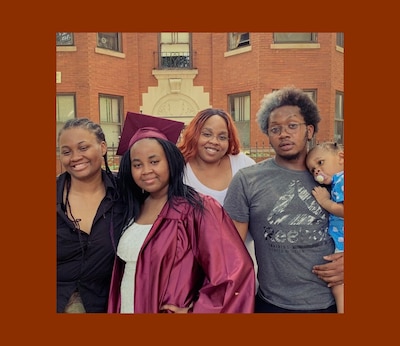
The mother of five also fears that CPS won’t provide her 4-year-old son who has autism with an adequate education. She’s already struggled to secure bus transportation for him this year, and she’s heard frustrations from parents of older students with disabilities who have had trouble securing services they’re entitled to.
If Flowers left Chicago, she’d follow in the footsteps of many friends and family members, some who found the city too expensive, she said.
“Everyone I know, that I was close to, has left the city,” Flowers said.
As neighborhoods gentrify, schools face stark choices
The demographic changes in Chicago Public Schools are largely a reflection of a changing city, experts said.
From 2010 to 2020, Chicago’s population grew by 2%. The median household income also grew by more than $20,000, according to U.S. Census estimates. But during that time, the school district saw enrollment decline by 60,000 students. In recent years, the city’s population has dipped by 3%, driven in part by an exodus of working class families.
“The share of working class families in Chicago is decreasing with time, as its industry and economy shifts toward white collar jobs that skew upper class, college educated,” said William Scarborough, the lead author of the UIC report, who is now an associate professor of sociology at the University of North Texas.
School closings, including the mass closures under former Mayor Rahm Emanuel, may have also pushed some working-class families to leave the city if they lost a beloved neighborhood school, Scarborough added. More people left the majority Black census tracts that experienced those 2013 school closures versus similar areas that did not, according to a WBEZ/Chicago Sun-Times investigation.
As schools lost students, some principals doubled down on enrolling the kids who lived in their neighborhood.
That’s what happened at Alexander Hamilton Elementary School in Lake View on the North Side, which saw one of the biggest drops in the share of students from low-income families. In 2013, Hamilton enrolled nearly 40% of children from low-income households, according to district data. That dropped to roughly 9% last school year.
James Gray, who was the principal from 2009-17, inherited an enrollment crisis when he took over Hamilton, which had narrowly escaped closure. The school enrolled 243 students when he arrived – roughly half of the almost 500 it served in 1999. He set out on what he called a “guerrilla effort” to sign up more neighborhood children, offering tours of the school, hosting weekend events and open houses, and even venturing to the park to chat up parents of toddlers — or potential future students.
Gray was successful. By the time he left, enrollment had jumped back up to about 480 students. He noticed that his students were increasingly coming from wealthier families. They were also more white. But that’s who lived in the neighborhood.
In 2013, the school was 47% white, 12% Black, 30% Hispanic and 4% Asian. Last school year, 73% of students were white — on par with the racial makeup of Lake View — while just 3% were Black, just under 13% were Hispanic, and nearly 4% were Asian American. (Hamilton’s current principal did not respond to a request for an interview.)
Though the shifts at individual schools can be stark, the racial breakdown districtwide has only changed slightly. As of last school year, the district’s students were 4% Asian American, 11% white, 36% Black, and 46.5% Hispanic. Ten years ago, 3% were Asian American, 9% were white, 40.5% were Black, and close to 45% were Hispanic.
Research has shown that students in diverse schools, both socioeconomically and racially, perform better academically than schools that are not integrated.
At the same time, families who become the minority may not feel as included or even shut out from their schools. As more neighborhood white families enrolled at Hamilton, Gray said, he received an anonymous note that said he had “driven Black and brown families away.”
It also stung when former students would visit and notice improvements at the school — bankrolled, in part, by parent fundraising efforts — such as new hoops and backboards in the gym and a new science lab.
They would say some version of, “Oh Mr. Gray, I wish you could have done this while I was here,” he recalled.
“They realized their experience was different from the kindergarteners or first graders’ experience over time,” Gray said.
While the demographic shifts have led to more income and racial diversity at some schools, that diversity could be fleeting as gentrification continues to push longtime neighborhood families out.
John-Jairo Betancur, professor of urban planning and policy at UIC, said as property values “dramatically” increase, families — and their children — leave for other neighborhoods or the suburbs, causing enrollment in the local schools to drop. At the same time, birth rates are declining in Chicago and more households do not include children, Betancur noted.
That has happened in Logan Square, home to Lorenz Brentano Math & Science Academy elementary school.
Similar to Hamilton, Brentano was at risk of closure due to low enrollment in 2013. Principal Seth Lavin’s priority when he became principal in 2015 was to bring in more students. He, too, was successful through various efforts, giving more than 100 school tours his first year, he said.
Today, the school enrolls almost 700 children, a 62% increase from a decade ago. But the school looks different. Roughly 39% of students come from low-income households, a nearly 50 percentage point drop from 2013 when 88% did. The school has also become more diverse: Half of Brentano’s students are Hispanic, just over a third are white, and about 5% are Black. A decade ago, 85% of students were Hispanic, while 5% were white, and 4% were Black.
Lavin said he is worried that gentrification has already “pushed out a lot of families” and will continue to do so, leading to a “great sense of loss” for families who have long called Logan Square home, and believe Brentano is at the heart of their community.
“It’s heartbreaking that even as we grow, and there’s expansion and the programming and things we didn’t have before that we’re able to get because of enrollment growth, that we’re losing families that should have those things, too,” Lavin said.
‘We have to keep kids in neighborhoods’
Lavin can spot six buildings outside of Brentano that have been renovated and hiked up rent prices in the last several years. He said the city “desperately” needs affordable housing and a pathway to home ownership.
“If we want to keep kids in neighborhood schools, we have to keep kids in neighborhoods,” he said.
Mayor Brandon Johnson has said that building more affordable housing and boosting neighborhood schools are priorities for his administration. Specifically, the mayor wants to grow the district’s Sustainable Community Schools model, which provides extra money for wraparound support and programming.
Separately, Johnson’s vision for school funding would alleviate pressure on principals to enroll more children in order to have a well-resourced school, or even to avoid closure. Though in the past more students meant more funding, CPS officials have been shifting toward funding schools based on need, not just enrollment. But that comes as the district stares down financial challenges, including a fiscal cliff as COVID relief dollars are set to run out.
If the city does nothing to address issues such as affordable housing, Chicago will shift toward “a city that primarily serves elites,” said Scarborough, the author of the UIC report.
District officials have not yet researched the trend around losing students from low-income families, a spokesperson said.
But many principals have noticed these shifts for years.
Even with how her community has changed, Zaimi’s school has two counselors and more staff focused on academic intervention. Still, she wishes she had more funding to hire a parent resource coordinator who could work with families, as well as instructional coaches who could help new teachers or those using new strategies in the classroom.
After all, she emphasized, her students have a lot of needs, regardless of their income. And, last year, more than one-third — about 370 — came from low-income families. That’s larger than the enrollment of entire schools in Chicago.
Reema Amin is a reporter covering Chicago Public Schools. Contact Reema at ramin@chalkbeat.org.
Thomas Wilburn is the senior data editor for Chalkbeat. Reach Thomas at twilburn@chalkbeat.org.


